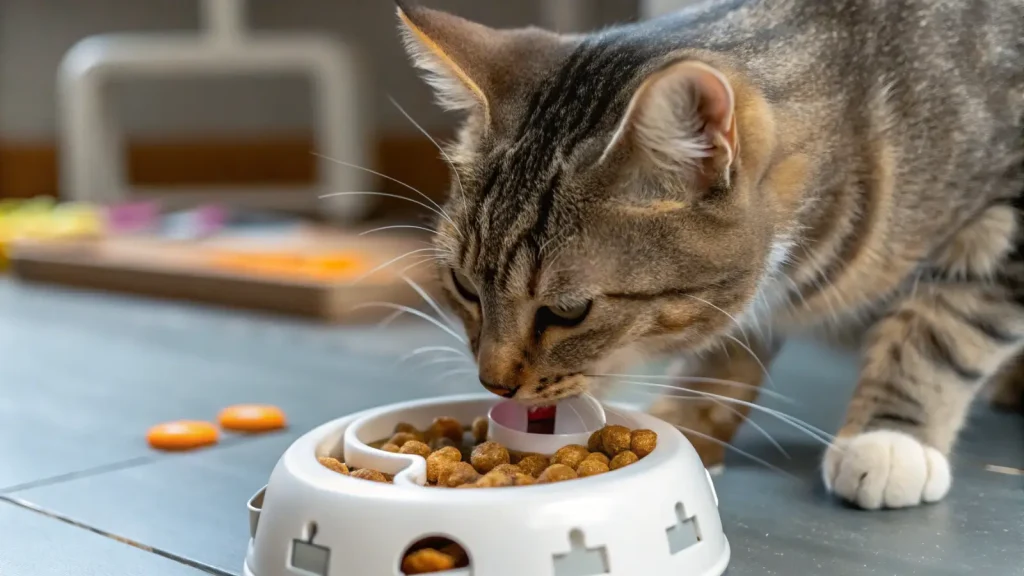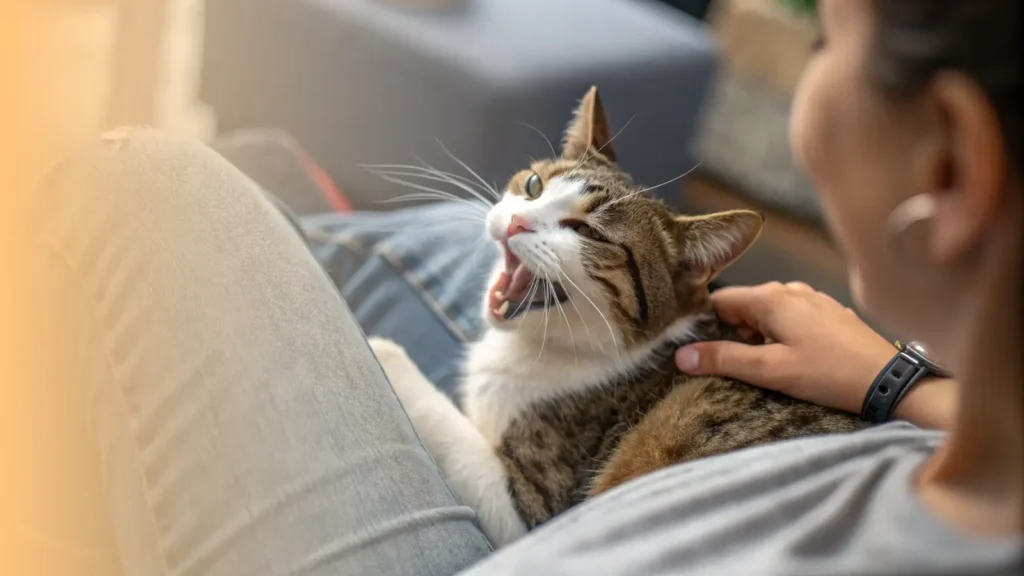Cat zoomies are a normal display of energy that shows your cat is healthy and playful. When these frantic bursts happen at the wrong times, a consistent daily routine can help channel that energy and create a calmer home. This guide provides a clear, practical plan to manage zoomies through habits that satisfy your cat’s natural instincts.
Key Takeaways
- The most effective way to reduce nighttime zoomies is to schedule a vigorous play session right before bed, followed immediately by your cat’s main meal.
- Enriching your cat’s environment with vertical space like cat trees, appropriate scratching posts, and puzzle feeders for meals reduces the boredom that leads to excess energy.
- A sudden change in your cat’s zoomie habits, especially in a senior cat or when paired with other symptoms, can signal a medical issue that requires a vet visit.
7 Daily Habits for a Calmer Cat
1. Schedule structured interactive play
Your cat needs a reliable way to burn off stored energy every day. A lack of physical activity is the most common reason for intense zoomies. You can manage this by dedicating 30 to 40 minutes total per day to interactive play, broken into two or three shorter sessions of 10 to 20 minutes each. Use a wand toy to mimic the movements of prey, allowing your cat to stalk, chase, and pounce.
2. Time the main play session before bed
Cats are most active at dawn and dusk, which is why they often get zoomies late at night. To align their sleep schedule with yours, make the most important play session a vigorous 15 to 20 minute hunt right before you plan to go to bed.
This session should tire your cat out, making it the perfect time for them to settle down for a long rest. A tired cat is much less likely to run through the house at midnight.
3. Serve the biggest meal after play
A cat’s natural rhythm is to hunt, catch its prey, and then eat. Serving your cat’s largest meal of the day immediately after your final play session completes this instinctual cycle.
This powerful sequence satisfies your cat’s predatory drive and signals that it is time to eat, groom, and then sleep. This simple habit is one of the most effective ways to encourage a full night of rest.
4. Build a vertical world for your cat
Cats feel safer and more secure when they can view their territory from a high vantage point. Providing vertical space increases their usable living area and builds confidence.
Add a sturdy cat tree that is at least 3 to 6 feet tall, preferably placed near a window to provide mental stimulation. Wall shelves or window perches are also excellent options for giving your cat a place to climb and rest.
5. Provide a variety of scratching surfaces
Scratching is an essential behavior for cats to maintain their claws, stretch their muscles, and mark their territory. A home without good scratching options leads to frustration and damaged furniture.
Offer both vertical and horizontal scratchers made of different materials like sisal rope and corrugated cardboard. A tall, stable scratching post should be at least 30 inches high to allow a full stretch.
6. Make your cat forage for food
Serving food in a bowl removes the mental work of hunting that cats need. Puzzle feeders reintroduce this challenge, turning a quick meal into an engaging activity.
This provides important mental stimulation, slows down eating for better digestion, and helps burn energy. Start with a simple puzzle feeder for your cat’s dry food to build their confidence before moving to more difficult ones.
7. Stick to a predictable daily routine
Cats thrive on predictability and find comfort in a consistent schedule. A reliable routine for feeding, play, and quiet time helps regulate their internal clock and reduces the anxiety that can cause stress related behaviors.
If your cat zooms at an inconvenient time, ignore the behavior completely. Punishing your cat will only create fear. Instead, redirect their energy with a structured play session at a better time.
Why Cats Get the Zoomies?
1. Releasing pent-up energy
The most common cause of zoomies is a simple release of unused energy. Cats are built to sleep for long periods to conserve energy for short, intense bursts of activity needed for hunting.
If your indoor cat does not get enough physical or mental stimulation, that stored energy will eventually overflow into a frenetic run around the house.
2. Acting on predatory instincts
Your cat is a natural predator with a deeply ingrained instinct to hunt. Zoomies often act as a simulation of a hunt, where your cat chases imaginary prey through its territory.
This behavior allows them to practice the sequence of stalking, chasing, and pouncing even when there is nothing real to hunt.
3. Following their internal clock
Many people think cats are nocturnal, but they are actually most active during the twilight hours of dawn and dusk. This is an evolutionary trait, as their natural prey is also most active at these times.
If your cat gets the zoomies late at night or very early in the morning, it is a direct result of their biological clock telling them it is a prime time to be active.
4. Expressing strong emotions
Zoomies can be an outward display of high emotional arousal, both positive and negative. A cat might zoom out of pure happiness after a fun play session or when you get home.
It can also be a way to release stress, such as after a tense interaction with another animal or after being startled by a loud noise.
5. Feeling relief after using the litter box
The frantic dash some cats do after using the litter box is often just an expression of physical relief. The act of defecation can create a brief, pleasant sensation that the cat expresses with a victory lap.
In some cases, it may also be a leftover instinct to move away from their waste quickly to avoid attracting predators.
Vet Red Flags for Cat Zoomies
While zoomies are usually normal, a sudden change in their frequency or intensity can signal a medical problem. The key is to look for hyperactivity that is paired with other new or concerning symptoms.
1. Weight loss with a huge appetite
This combination is a classic sign of hyperthyroidism, a common condition in middle aged and senior cats. An overactive thyroid gland puts their metabolism into overdrive, causing them to burn calories rapidly despite eating more.
If your cat over seven years old suddenly has more zoomies along with weight loss and increased appetite or thirst, schedule a non emergency vet visit for blood work.
2. Frantic running combined with pain
A cat may run frantically to try to escape a source of pain or severe irritation. This can be caused by the intense itching of a flea infestation, skin allergies, dental pain, or the discomfort of arthritis.
Look for other signs like excessive licking of one area, limping, stiffness, or irritability when touched. If you see these signs, schedule a vet visit.
3. Rippling skin on their back
Feline Hyperesthesia Syndrome is a disorder that causes extreme skin sensitivity, usually along the lower back. You may see the skin twitch or ripple, and your cat might suddenly bite or attack its own back or tail.
These episodes are often followed by an explosive burst of running. If you observe this behavior, try to take a video and see your veterinarian to rule out other causes.
4. Hyperactivity paired with chronic anxiety
While zoomies can be a healthy stress release, chronic anxiety can lead to more persistent hyperactivity. This is usually part of a larger pattern of distress. Anxious cats often show other signs, including constant hiding, excessive meowing, over grooming to the point of bald spots, or urinating outside the litter box. If hyperactivity is just one of several signs of stress, a veterinary consultation is recommended.
| Potential Condition | Key Signs to Watch For | When to Call the Vet |
| Hyperthyroidism | Weight loss, increased appetite, increased thirst, poor coat, excessive meowing. | If your senior cat has more zoomies plus weight loss, schedule a vet visit. |
| Pain or Discomfort | Limping, stiffness, over-grooming one spot, irritability, new post-litter box zoomies. | If hyperactivity is paired with any clear sign of pain, schedule a vet visit. |
| Feline Hyperesthesia | Visible skin twitching on the back, extreme sensitivity to touch, tail chasing. | If you see skin-rippling episodes, document them and schedule a vet visit. |
| Chronic Anxiety | Hiding, over-grooming, urinating outside the box, persistent vocalizing. | If zoomies are part of a larger pattern of anxious behaviors, schedule a vet visit. |
Essential Gear to Redirect Energy
1. Interactive wand toys
Wand toys are the best tool for interactive play because they let you simulate the entire hunting sequence. Most importantly, they allow your cat to have a satisfying physical capture at the end of the game. Look for toys with durable lures like feathers or fabric, and always put them away after a supervised play session to prevent your cat from chewing on them.
2. Sturdy and tall cat trees
A cat tree is a critical piece of furniture for enriching your cat’s environment. When choosing one, stability is the most important factor. It should have a wide, heavy base that does not wobble when your cat jumps on it. For adult cats, a height of 6 feet or more is ideal, with perches that are large enough for them to lounge comfortably.
3. Satisfying scratching posts
A good scratching post must be tall and sturdy enough for your cat to use with confidence. Look for a vertical post that is at least 30 inches tall, which allows your cat to get a full body stretch. The best material is tightly woven sisal rope or sisal fabric, as it is durable and very satisfying for cats to shred. Carpeted posts are less ideal because the loops can snag claws.
4. Engaging food puzzle feeders
Food puzzles provide essential mental stimulation and prevent boredom. When starting out, choose a very easy puzzle to teach your cat how to use it and avoid frustration. Look for puzzles made from food safe, non toxic materials that are easy to take apart and clean, especially if you plan to use them with wet food.
Common Questions About Cat Zoomies
1. Are nighttime zoomies normal?
Yes, it is completely normal for cats to be more active at night. Their internal clocks are programmed for peak activity at dawn and dusk. You can help manage this behavior by ensuring your cat gets plenty of play and a large meal right before you go to bed, which encourages them to rest when you do.
2. Can I use a laser pointer?
Laser pointers can be great for exercise, but they can also cause deep frustration because the cat can never physically catch the dot. This lack of a rewarding capture can lead to anxiety. If you use a laser pointer, you must always end the session by landing the dot on a physical toy or a treat that your cat can pounce on and “kill” for a satisfying finish.
3. How do I manage zoomies in a small apartment?
In a small space, using vertical territory is the best strategy. A tall, narrow cat tree can dramatically increase your cat’s living area without taking up much floor space. You can also use window perches with suction cups or tension rod cat poles that go from floor to ceiling. These options provide enrichment without requiring you to drill holes in the walls.
4. Why does my Breed cat have zoomies?
All cat breeds experience zoomies. However, flat faced breeds like Persians or Exotic Shorthairs have breathing difficulties that can make intense exercise dangerous. For these cats, play sessions must be short, low intensity, and closely monitored for any signs of respiratory distress like open mouth breathing. Always prioritize their safety during play.
Final Thoughts
Managing cat zoomies is about understanding and redirecting your cat’s natural energy, not trying to eliminate it completely. By creating a predictable daily routine of play, enrichment, and properly timed meals, you can meet your cat’s instinctual needs. This approach builds a healthier, more peaceful relationship between you and your feline companion.







